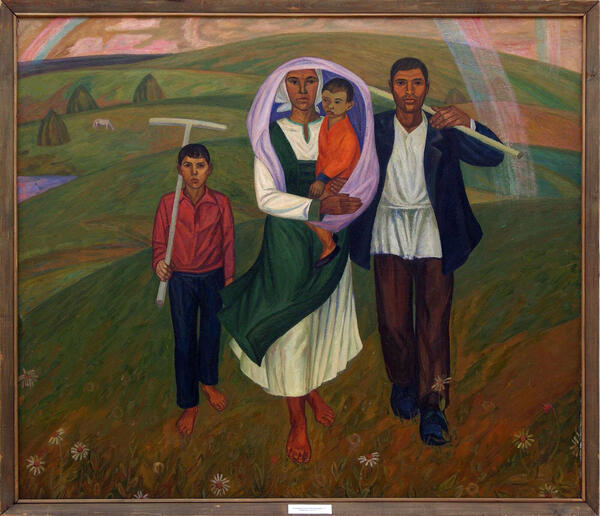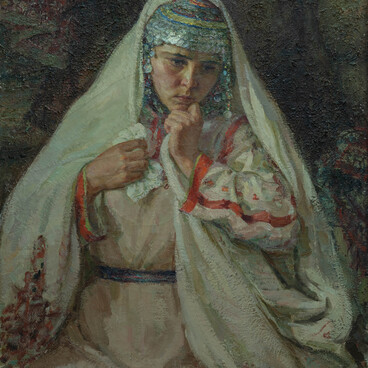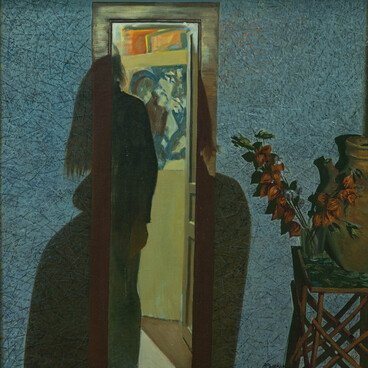Klimentiy Vladimirov was a painter, a graphic artist, and an art teacher. He was born on March 14, 1940, in the village of Nimichkasy, Krasnoarmeysky district, Chuvash Republic. After finishing school, he served as a submarine sailor in the Soviet Pacific Fleet for four years. The artist graduated from the Art and Graphics department of the Chuvash State Pedagogical University named after Ivan Yakovlev. He would later be engaged there as a professor at the School of Fine Arts, as well as work in children’s art schools in the city of Cheboksary. In 2003, he was awarded the title of People’s Artist of the Chuvash Republic.
The works of Klimentiy Vladimirov are unique for their of combination of features typical of genre painting and symbolism in one composition, enabling them to convey the continuity of eras and generations.
Vladimirov’s most famous works include the paintings called “In the Village”, “Morning”, “Family from the Village of Aslӑ Yal”, “Source”, “Apple Orchard”, “A Mother’s Bliss”, “The Young”, “Sons”, “Old Cheboksary”, “A Chuvash Mother”, “I Was Born. There Was a War”, and “Departing for War”.
The characters in his paintings are people from Chuvash settlements and villages. Their images can be called encompassing, for they are never tied to a specific time and rarely so to specific sitters. They comprise the most typical features of the Chuvash people at the key moments of their everyday life: their morning and evening routine, work in the field and festivities on the bank of a wide river, dates and weddings, long summer days and short-lived winter sunsets. At the center of the artist’s universe is a happy family, which takes gentle care of their babies, respects their elders, honors the traditions of their ancestors and passes them down for generations. They spend their lives in a cheerful and balanced way, working and enjoying a close connection with nature and the hills and ravines of their native land.
All that is reflected in the painting titled “New Day”. After a warm summer rain, the family returns from haymaking. The mother carries her youngest son in her arms as if to show that the everlasting connection between generations can never be broken. Her figure conjures up the images of mothers from Renaissance paintings. Two rainbows seem to embrace wide fields covered with greenery and flowers. The painting shows the pure beauty of the people of the new day.
The works of Klimentiy Vladimirov are unique for their of combination of features typical of genre painting and symbolism in one composition, enabling them to convey the continuity of eras and generations.
Vladimirov’s most famous works include the paintings called “In the Village”, “Morning”, “Family from the Village of Aslӑ Yal”, “Source”, “Apple Orchard”, “A Mother’s Bliss”, “The Young”, “Sons”, “Old Cheboksary”, “A Chuvash Mother”, “I Was Born. There Was a War”, and “Departing for War”.
The characters in his paintings are people from Chuvash settlements and villages. Their images can be called encompassing, for they are never tied to a specific time and rarely so to specific sitters. They comprise the most typical features of the Chuvash people at the key moments of their everyday life: their morning and evening routine, work in the field and festivities on the bank of a wide river, dates and weddings, long summer days and short-lived winter sunsets. At the center of the artist’s universe is a happy family, which takes gentle care of their babies, respects their elders, honors the traditions of their ancestors and passes them down for generations. They spend their lives in a cheerful and balanced way, working and enjoying a close connection with nature and the hills and ravines of their native land.
All that is reflected in the painting titled “New Day”. After a warm summer rain, the family returns from haymaking. The mother carries her youngest son in her arms as if to show that the everlasting connection between generations can never be broken. Her figure conjures up the images of mothers from Renaissance paintings. Two rainbows seem to embrace wide fields covered with greenery and flowers. The painting shows the pure beauty of the people of the new day.



